- Guest Editor’s Column
- Docedge the Asian documentary forum
- Creative Impulse
- Arts and Crafts Movement : Mission Style Furniture
- Porcelain-enamel Advertising Signs
- Passions run high over the auction of Tagore's paintings
- In the News
- Controversy
- Artist Index and Statistics
- Market Insight
- Auction Reports : What happened
- Auction Reports : what's forthcoming
- Art's eye-view
- The month that was
- Mumbai Artsighting
- Art Bengaluru
- Musings from Chennai
- Deccan Odyssey
- North-East Opsis
- The Wreckage
- Inscription in Bronze
- Black and White
- Nature God
- Indian Highway
- Structures Within an Intervention
- Hard Talk
- Different hues of Aakriti
- Christie’s : Important Watches
ART news & views
Porcelain-enamel Advertising Signs
Volume: 2 Issue No: 5 Month: 6 Year: 2010
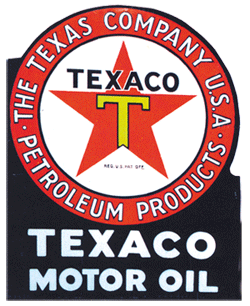 Texaco die-cut signs manufactured in the 1920's.(18" x 23") Price approx. Rs. 20,000 |
For its sheer beauty, variety, longevity and eye-catching appeal porcelain, enamel advertising had been the most popular advertising media even in the recent past. One could not help coming across such advertising signs wherever s/he went, shops or offices, petrol pumps or railway stations, river routes or highways. Time has changed now and it will be a rarest of the rare occasion if one can zero in on one such advertisement in a public place anywhere in the world. It is now an adorable and prospectively lucrative collectible for the qualities that had once assured its sovereign place in the field of advertising. To add to it the graphic, art and touches of history it is steeped in makes it far more valuable.
Porcelain-enamel is actually powdered glass fused onto iron. Initially rolled iron was used for this purpose. A base coat of one colour was fired after which stenciling was done to represent different coloured areas. The graphic would be finished by firing one on top of another. The huge thickness of all the layers of paint would give it a 3D effect.
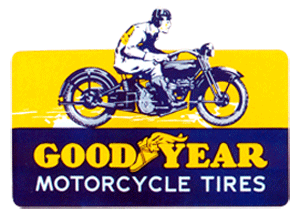 Good Year die-cut motorcycle tires sign (24" x 17") dates to the 1920's. Price approx. Rs. 2,00,000
|
To get to the beginning of the porcelain-enamel advertising one would not have to travel much into the abyss of history. It all started in Germany and England and in some other places of Europe during the fag end of the nineteenth century i.e, around 1880. A decade later the art of porcelain enamel manufacturing entered the U.S.A. The first to begin was Enameled Iron Company of Pennsylvania which was followed by others. Big companies like Ingram-Richardson, Baltimore Enamel and Novelty started production.
The United States imported the techniques from Europe. Even some of the labour force also was brought in. In the beginning the American porcelain signs were not so attractive, but with the beginning of the 20th century colour & art in these signs began to flourish.
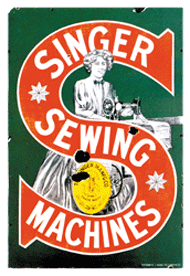 "Singer Sewing Machines" wall mount sign. Measures 24" x 36", and dates to around the 1930's, stamped "F. Francis and Sons Ltd. London S.E." at the bottom. Price approx. Rs. 20,000 |
Back in England during the Victorian and Edwardian period porcelain enamel advertising won new peaks of success as they became highly artistic with elaborate fonts and 3D letter. Deft commercial graphic artists did the art itself though most of them were not allowed to put their names on their works. Tom Browne, John Hassall and few other big names are associated with porcelain-enamel signs of the period.
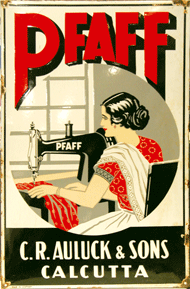 "Pfaff Sewing Machines" wall mount sign. Measures 35" x 23". Printed at Germany (1940s) for Indian Market. Price approx. Rs. 15,000
|
After the 1st World War modern graphics were introduced. And the period of the post World War II saw much of its colours reduced. There were not diverse colours and everything was a bit cheaper in quality. During World War II there were extensive scrap drives. Most of the signs that were lying around were scrapped. Many of the products that were advertised on the porcelain signs were no longer in use and so the signs were brought down and dumped in places. The scrap drive of World War II destroyed them and also a significant portion of heritage was lost as well.
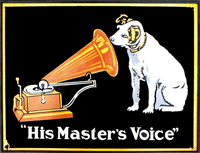 "His Master's Voice" is a recognized trademark in USA. This particular sign was found not in USA, but in India. Price approx. Rs. 15,000 |
During its heyday porcelain-enamel signs were produced worldwide, including England, France, Germany, Belgium, Czechoslovakia, USA, Australia and India. Wolverhampton, Birmingham, Burnham and London were the most famous companies of England. The Belgian/France Enamel Co., Stalker Enamels of Germany and Frankfurter Emaillierwerke were eminent European producers. The Bengal Enamel Co. & Sur Enamel Co. Of Calcutta, O.G Works in Ogalevali,India, were some of the well known Asian companies.
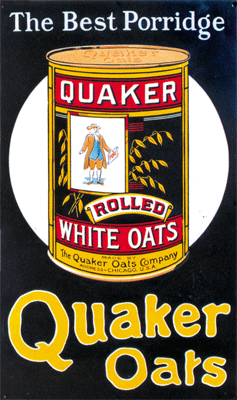 The colourful Quaker Oats sign (18" x 30") was in use around the 1890's. Price approx. Rs. 35,000
|
Advertisers were all out in favour of porcelain-enamel advertising because in addition to all other qualities it was cost-effective and long-lasting. The stuff of such a sign would lose little of its quality even if it was exposed to the elements of environment. Protected it would shine like new even after a century. When produced in huge quantity it was relatively cost-effective. Ironically enough it was the rising costs of production of porcelain-enamel which eventually stopped porcelain sign making. Compared to paint or silk-screen on thin metal, it is labour intensive. A piece of cheap metal cannot be used in porcelain enamelling. Alternative methods of advertising took its place and gradually it lost its significance. By the 1970s the production of porcelain-enamel advertising came to an end in America and also in other parts of the world.
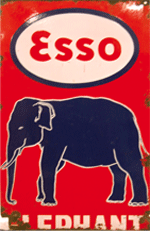 Esso sign (20" x 12") was in use around the 1950's. Printed by Bengal Enamel. Price approx. Rs. 3,500 |
The variety of products advertised in porcelain-enamel is almost innumerable. Almost all kinds of products were advertised in porcelain. The list is a huge one but the leaders in the list would be petroleum signs, automobile signs and gasoline. Porcelain advertising was also much utilized by beer, paints, varnishes, telephone, tobacco, cigar, soda pop, chocolate bars and food item manufacturers. To have an idea of variety mentions can be made of railroad signs, highway signs, farm signs, newspaper signs, door pushes and pulls etc.
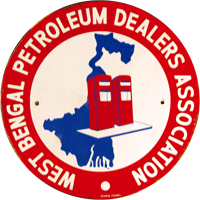 WBPDA die-cut signs (15" dia) manufactured by Bengal Enamel (1960's). Price approx. Rs. 2,000
|
Porcelain-enamel advertising signs have become a hot collectible because they are no longer being manufactured and have been removed from public viewing for a considerable number of years. It is in the collector's market where one can find them. The beauty and art, longevity and diversity and the flavour of periodic history are making it more and more popular. It caters to one's hobby as it can be bought, sold or traded. Beginning from 1970s collecting porcelain-enamel advertising is gradually peaking importance with the passing of years. Michael Bruner, an internationally famous expert and collector, connoisseur of Porcelain advertising signs, opines that in his judgment collecting porcelain advertising will pay heavy dividend and in one of his long interviews he recollects that it will “go through the roof.”
In India, recently there has been a growing interest among the people to collect the enamel signs. But it's a matter of time when it can become a mainstream collectible.
Anindya Bandyopadhyay